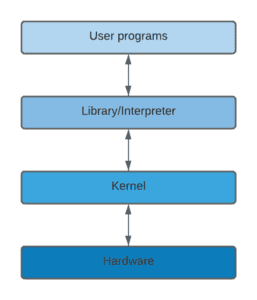1. 简介
在操作系统中,用户模式(User Mode) 与 内核模式(Kernel Mode) 是两个核心概念。本文将深入解释这两个模式的定义、作用以及它们之间的区别。同时也会说明操作系统为何要设计这样的机制。
2. 定义
早期的计算机系统中,程序可以直接访问硬件资源。这种设计虽然简单,但非常不稳定,一旦程序出错,整个系统都可能崩溃。为了解决这个问题,现代操作系统引入了两种运行模式:用户模式和内核模式。
- 内核模式(Kernel Mode):也称为系统模式,是 CPU 的一种特权模式。在此模式下运行的程序可以无限制地访问硬件资源和内存。
- 用户模式(User Mode):是 CPU 的非特权模式。应用程序通常在此模式下运行,对硬件和内存的访问受到严格限制。
这种分离机制确保了系统的稳定性与安全性。
3. 用户模式与内核模式的必要性
操作系统的核心是 内核(Kernel),它是系统启动时加载到内存中的核心程序,负责管理硬件资源并为应用程序提供运行环境。
操作系统需要完成两个主要任务:
- 与硬件交互,管理底层可编程组件
- 提供一个环境,让应用程序(用户程序)可以安全运行
像 MS-DOS 这样的老系统允许应用程序直接访问硬件,而类 Unix 系统(如 Linux、macOS)则通过内核模式保护硬件细节。用户程序必须通过系统调用请求内核代为操作。
下图展示了现代操作系统中用户空间与内核空间的交互关系:

✅ 重点:用户程序不能直接访问硬件,必须通过系统调用向内核提出请求,由内核在内核模式下执行相关操作。
这种机制依赖于硬件的支持,例如 CPU 必须具备至少两种执行模式:用户模式与内核模式。
3.1. 保护环机制(Protection Rings)
保护环是实现用户模式与内核模式隔离的常见机制,其核心思想是通过分层权限控制资源访问,从而提高系统的容错性和安全性。
常见的 CPU 架构如 x86 支持多个保护环层级:
- Ring 0:最高权限,用于运行内核
- Ring 3:最低权限,用于运行用户程序
下图展示了保护环的层级结构:

⚠️ 注意:不同操作系统对保护环的使用方式不同,但大多数只使用 Ring 0 和 Ring 3,分别对应内核模式和用户模式。
3.2. 不同操作系统中的保护环示例
- Linux / Windows / macOS:这些系统中,用户程序运行在 Ring 3,必须通过系统调用进入内核模式(Ring 0)来完成特定操作。
- DOS / 某些嵌入式系统:所有程序都运行在内核模式,虽然简化了开发流程,但存在安全风险。例如 IoT 设备如果运行在 Ring 0,一旦程序出错,可能导致整个系统崩溃。
4. 从用户模式切换到内核模式
用户程序在用户模式下无法直接访问硬件资源,但在某些情况下必须切换到内核模式。例如:
- 读取磁盘文件
- 获取键盘输入
- 修改进程调度策略
操作系统必须提供一种安全机制,允许用户程序发起请求,由内核代为执行。这种机制就是 系统调用(System Call)。
4.1. 系统调用(System Call)
系统调用是一种特殊的函数接口,用于在用户模式和内核模式之间安全地传递控制权和数据。
系统调用的工作流程如下:
- 用户程序将请求参数放入寄存器或堆栈中
- 执行
trap指令(也称为软中断) - CPU 切换到内核模式,跳转到系统调用处理程序
- 内核处理完请求后,将结果返回用户程序
- CPU 切换回用户模式,程序继续执行
// 示例:Linux 下的系统调用
#include <unistd.h>
int main() {
char *msg = "Hello, world!\n";
write(1, msg, 14); // 系统调用:write
return 0;
}
✅ 系统调用的典型使用场景:
- 获取进程 ID(
getpid()) - 读写文件(
open(),read(),write()) - 修改进程调度策略(
sched_setscheduler())
⚠️ 系统调用是用户模式访问底层资源的唯一合法方式。任何试图绕过它的行为都会被硬件阻止。
4.2. 为何信任操作系统?
运行在内核模式下的程序拥有系统最高权限,可以访问所有资源。因此,我们必须信任操作系统本身。
虽然这种信任是强制性的,但我们可以通过以下方式降低风险:
- 使用开源内核(如 Linux),方便审查代码
- 启用内核模块签名机制,防止非法模块加载
- 限制用户权限,减少内核暴露面
5. 总结
本文介绍了:
- 用户模式与内核模式的定义
- 为何操作系统需要这两种模式
- 保护环机制及其在不同系统中的实现
- 如何通过系统调用切换到内核模式
- 为什么我们必须信任操作系统
理解这些机制有助于我们更好地掌握操作系统的工作原理,也能帮助我们在开发中做出更安全、高效的系统设计决策。